Did you know about Hindu Temple Architecture? How this Temple Architecture Elements Evolve in the History? If you have a idea and knowledge of Hindu mythology. It’s evolution, then this term Hindu temple architecture style or Hindu architecture elements are easy to understand. Be with us ahead of this collection on Hindu temple design style. This will help you to clear the clouds of doubt, about Elements of Hindu Temple architecture. Around the region of followers of Hindu Religion, In and around India.
Because architecture of Hindu temples evolved over a period of more than 2,000 years, and there is a great variety in the Hindu Temple Architecture Style.
Hindu Temple Architecture Design.
Let’s get the ideas of Hindu Temple Architecture Styles First.
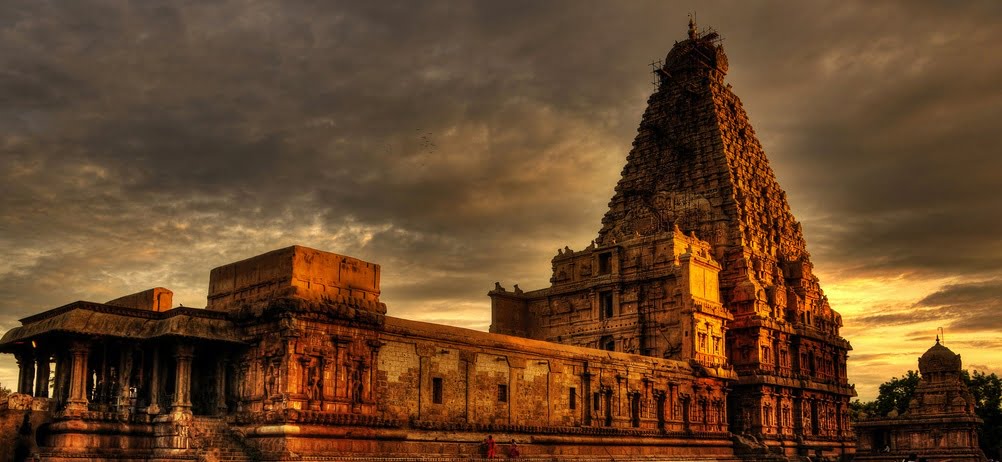
Hindu Temple Architecture and Human Body:
- The Hindu temples are of different shapes and sizes, like rectangular, octagonal, semicircular.
- Temples have with different types of architectural elements like, Torana, shikhar, domes and gates.
- Temples in southern India have a different style, than those in northern India.
- The architecture of Hindu temples is vary. They mainly have many things in common.
Important Hindu Temple Architecture Characteristics:
There are mainly 6 parts in the Hindu temple Design and Development. Those temple parts are derive and develop on the base of Hindu Shastras. Direct influence of Old and Ancient Literature on the development of Hindu Temple Architectural Style.
Let’s get the ideas of Different part or features of Hindu Temple.
The Front Porch of Temple:
This area of the temples usually has a big metallic bell. that hangs from the ceiling. Devotees entering and leaving the porch ring this bell to declare their arrival and departure.
The Temple Hall:
Most large temples have a hall meant for the audience to sit. This is also called the ‘nata-mandira’ (hall for temple-dancing). where in days of yore, women dancers or ‘devadasis’ used to perform dance rituals. Devotees use the hall to sit, meditate, pray, chant or watch the priests perform the rituals. The hall is usually decorate with paintings of gods and goddesses.
The Inner Chamber of Temple:
The inner chamber of the temple called ‘Garbhagriha.’ or ‘womb-chamber’ is where the image or idol of the deity (‘murti’) is place. In most temples, the visitors can not enter the garbhagriha. Only the temple priests are allow inside.
Hindu Temple Architecture Characteristics:
The Walkway around the Temple:
Most temples have a walkway around the walls of the inner chamber. for circus-ambulation by devotees around the deity. as a mark of respect to the temples god or goddess.
The Dome and Steeple on the Temple:
The steeple of the dome is know as ‘shikhara’ (summit.) That represents the mythological ‘Meru’ or the highest mountain peak. The shape of the dome varies from region to region. And the steeple is often in the form of the trident of Shiva.
The Reservoir in Temple Complex:
If the temple is not in the vicinity of a natural water body. A reservoir of freshwater is create on the temple premises. The water is use for rituals as well as to keep the temple floor clean or even for a ritual bath before entering the holy abode.
Hindu Temple Architecture in India.
Although, there are numerous regional variants of the Hindu Temple Architecture. They can basically be classified under the Nagara or the north Indian and the Dravida or the south indian styles.
We will briefly examine aspects of these styles (as explained in ancient texts like the Mayamata, Tantrasamuchchaya and Suprabhedagama) and their commonalities.
Hindu Temple Architecture Nagara Style:
The Nagara style is characterize by a beehive shaped tower (called a shikhara).
Shikhara is make up of layer upon layer of architectural elements. Such as kapotas and gavaksas, All topped by a large round cushion-like element call an amalaka.
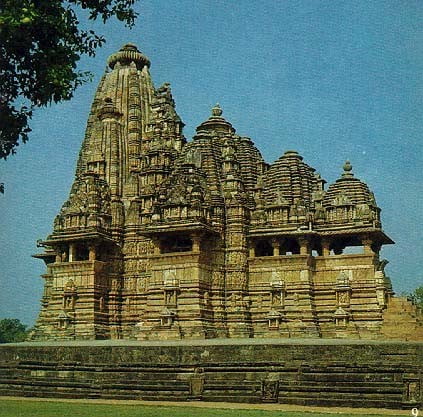
The Hindu temple architecture nagara style plan is based on a square, but the walls are sometimes. So broken up that the tower often gives the impression of being circular.
The central shaft could be surrounded by smaller secondary shafts called the Urushringas. That is creating a spectacular visual effect resembling a fountain.
Dravida Style in Hindu Temple Architecture:
The Dravida Architecture Style is characterized by a pyramid shaped tower. That is consisting of progressively smaller storeys of small pavilions.
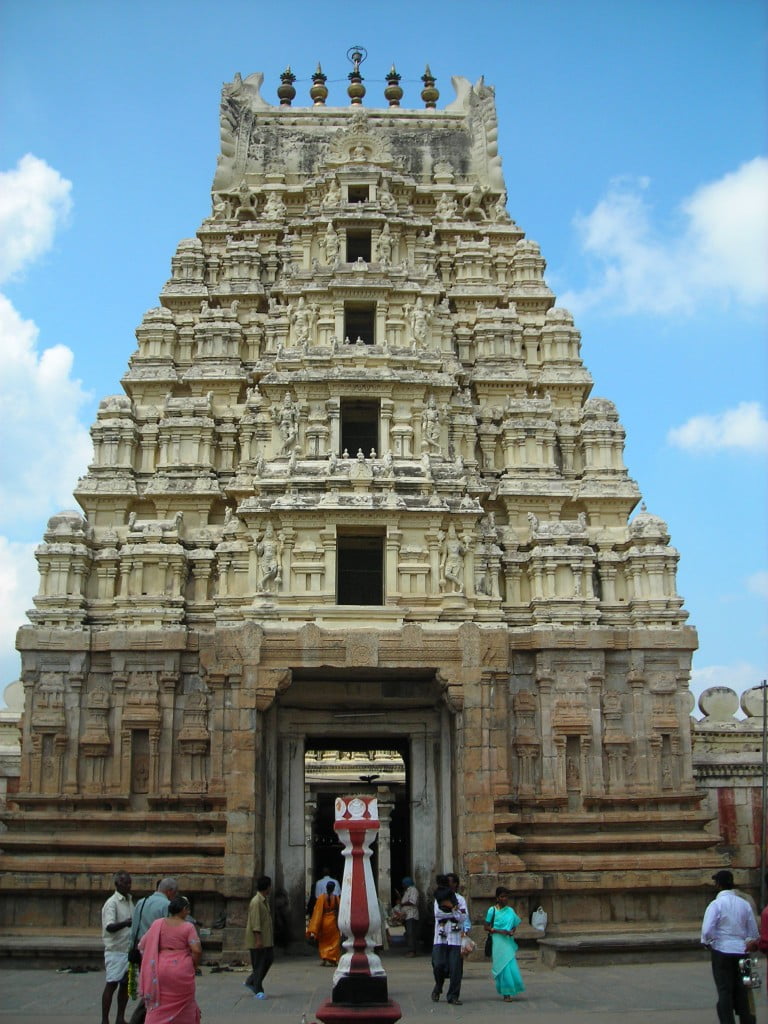
A narrow throat, a dome on the top called the Sikharam or the Vimanam. The repeated storeys give a horizontal visual thrust to this Hindu temple architecture style.
Vesara Style Hindu Temple Architecture:
Temple Architecture style Vesara is basically combination of the Nagara and the Dravida styles.
Vesara style hindu temple architecture is evolve in Karnataka during the medieval centuries. Vesara Style Temple architecture actually reduces the height of the individual tiers, without reducing their numbers.
So, this method resulting in a reduction in the height of the temple towers.
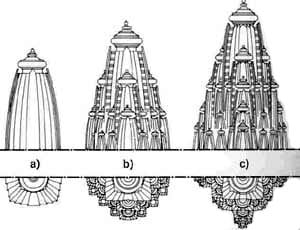
The semi-circular structures of the Buddhist Chaityas are also incorporated in some of the Hindu temple architecture style.
The temples of Halebid, Belur, Somnathapura and Pattadakal are some of the examples of this Vesara Hindu Temple Architecture style.
Hindu Temple Architectural Style of Other Countries
The famous Angkor Wat of Cambodia. The largest Hindu temple in the world.
This Hindu temple architecture is a combination of Dravida and Khmer styles of architecture. While the massive Prambanan temple complex of Java.
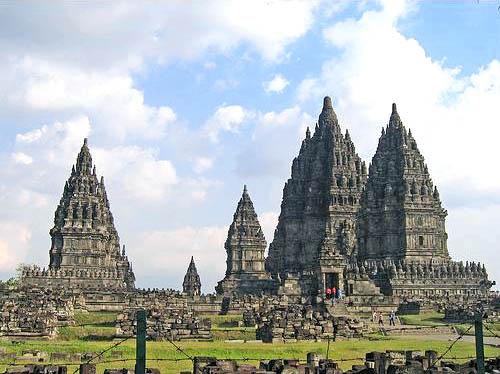
Indonesia follows the Mandala precepts of Vasthu Sastra. Also, it’s soaring spires are reminiscent of the Nagara Shikharas.
Hindu Temple Architectural Features:
Bellow image shows an important features of temple design.
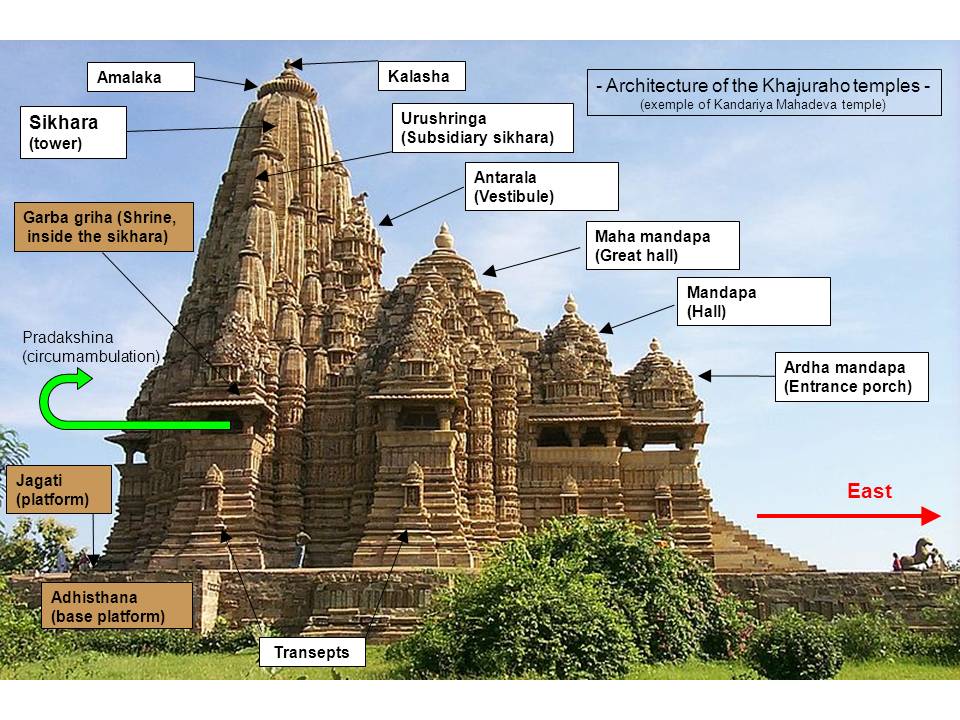
Hindu temple architecture significance:
- Hindu philosophical and metaphysical concepts dominate the architecture of the temple. Whatever it’s style.
- The basic layout of a temple design can be visualized as a Mandala. A miniature representation of the cosmos.
- The Mandala is a mystical Hindu symbol represented by a square enclosing a circle.
- Square denotes not just the four directions but also a perfection of form and symmetry making it de rigueur for temple architecture.
- The Mandala is subdivided into a grid of smaller squares: 64 and 81 are the most commonly used.
- Each square is invested metaphysically with a resident deity.
- Each component of the temple is then sited on a particular square.
- A Mandala that forms the basis for a temple’s layout is termed a Vasthupurusha Mandala.
- All temple usually consists of the following parts: the Garbhagraha (or the Sanctum Sanctorum) containing the diety, the Vimana/Shikhara, the tower rising over the Sanctum, the Mandapa in front of the Sanctum, the Prakaras around the Sanctum and the Gopura, the gateway(s) to the temple.
- The layout of a temple can also be analogous to the human body.
- The vimana is the head, the Sanctum is the neck, the front mandapa is the stomach, the prakara walls are the legs, the gopura is the feet and the Lord in the Sanctum is the Soul or the Jiva of the body.
Ref : Wiki.
Facts Of Hindu Temple Architecture Style:
Indian architecture, belonging to different periods of history. That is bears the stamp of respective periods. Though the cities of Indus Valley provide substantial evidence of extensive town planning. The beginnings of Indian architecture can be traced back to the advent of Buddhism in India.
It was in this period, that a large number of magnificent buildings came up. Some of the highlights of Buddhist art and architecture. The Great Stupa at Sanchi and the rock-cut caves at Ajanta.
With the establishment of Hindu kingdoms in South India. The south Indian school of architecture began to flourish. The most notable achievements of the Pallava rulers were the rock-cut temples of Mahabalipuram and the temples of Kanchipuram.
The Chola, Hoyasala and Vijayanagar rulers also did remarkable job in the field of architecture. The temples at Thanjavur, Belur and Halebid bear testimony to the architectural excellence of the South Indian rulers.
In north India, there developed a new a different style of architecture. This was called as the Nagara style architecture. In central India, the Chandela rulers built a magnificent temple complex at Khajuraho.







Interesting perspective about the temples. Thanks for sharing